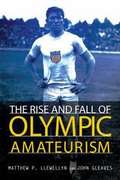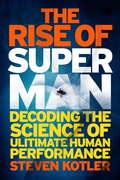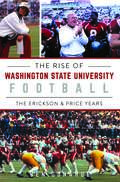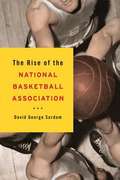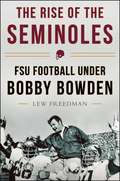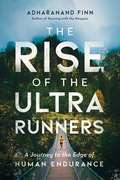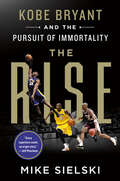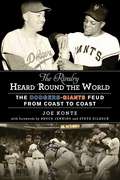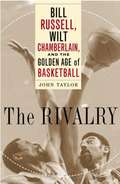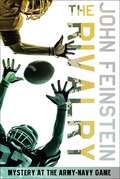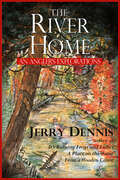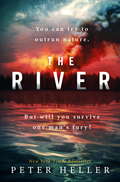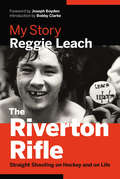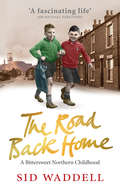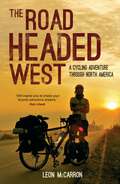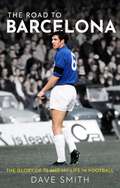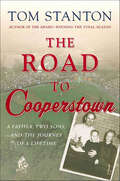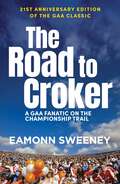- Table View
- List View
The Rise and Fall of Olympic Amateurism
by John Gleaves Matthew P LlewellynFor decades, amateurism defined the ideals undergirding the Olympic movement. No more. Today's Games present athletes who enjoy open corporate sponsorship and unabashedly compete for lucrative commercial endorsements. Matthew P. Llewellyn and John Gleaves analyze how this astonishing transformation took place. Drawing on Olympic archives and a wealth of research across media, the authors examine how an elite--white, wealthy, often Anglo-Saxon--controlled and shaped an enormously powerful myth of amateurism. The myth assumed an air of naturalness that made it seem unassailable and, not incidentally, served those in power. Llewellyn and Gleaves trace professionalism's inroads into the Olympics from tragic figures like Jim Thorpe through the shamateur era of under-the-table cash and state-supported athletes. As they show, the increasing acceptability of professionals went hand-in-hand with the Games becoming a for-profit international spectacle. Yet the myth of amateurism's purity remained a potent force, influencing how people around the globe imagined and understood sport. Timely and vivid with details, The Rise and Fall of Olympic Amateurism is the first book-length examination of the movement's foundational ideal.
The Rise and Rise of Illegal Ticket Touting: An Ethnography of Deviant Entrepreneurship (Routledge Studies in Organised Crime)
by Alessandro MorettiThis book presents an ethnographic study of contemporary ticket touts in the UK. Despite the recent interest in the topic of black-market ticket sales, media coverage and parliamentary interventions over the last ten years have revealed a widespread lack of knowledge with regards to the phenomenon of touting and the players involved in the practice. The Rise and Rise of Illegal Ticket Touting sheds light on the world of touting and delivers an authentic picture of the individuals involved, of their methods, values, and motivations for performing ticket touting as an organised, entrepreneurial deviant activity. The touts’ attitudes, perceptions, adaptations to – or outright dismissal of – the changing legal landscape are focal points of the study. Of equal importance are the touts’ varied methods of buying and selling tickets, the hierarchical structures and strict ethos of their criminal organisations, and their specific modi operandi for evading detection and arrest both on the streets and online. This book illuminates why historic and renewed attempts to challenge ticket touting have been unsuccessful, focusing on inadequate legislation, a lack of enforcement, and the widespread corruption and exploitable loopholes that exist within the official, primary ticket market. An accessible and compelling read, The Rise and Rise of Illegal Ticket Touting will appeal to students and scholars of criminology, sociology, social policy, policing and all those with an interest in live music and sport and the hidden practices that lurk beneath the surface.
The Rise and Size of the Fitness Industry in Europe: Fit for the Future?
by Jeroen Scheerder Hanna Vehmas Kobe HelsenThis book explores the rise, size and shape of the European fitness industry by using harmonised data as well as in-depth analyses of national surveys in fifteen European countries. Following an introduction to the socio-historical and conceptual aspects of fitness, the collection presents the scope of fitness as a business and participatory activity. Furthermore, both policy and governance issues as well as community and supply angles are considered. Drawing on this unique material, the book will appeal to students and scholars of sport business, sport economics, sport management, and social sport sciences, but also to administrators, policymakers and entrepreneurs in the international and national sport and health community.
The Rise of Superman: Decoding the Science of Ultimate Human Performance
by Steven KotlerA razor-sharp analysis of how record-breaking exploits in extreme sport are redefining the limits of being human.Right now, more people are risking their lives for their sports then ever before in history. As Thomas Pynchon once put it in Gravity's Rainbow, 'it is not often that Death is told so clearly to f@%* off'. Over the past three decades, the bounds of the possible in action and adventure sports - from sky-diving to motocross to surfing and beyond - have been pushed farther and faster. A generation's worth of iconoclastic misfits have rewritten the rules of the feasible; not just raising the bar, but obliterating it altogether. Along the way, they have become a force pushing evolution relentlessly onward. In a thrilling narrative that draws on biology, psychology, and philosophy, Steven Kotler asks why, at the tail end of the 20th century and the early portion of the 21st, are we seeing such a multi-sport assault on reality? Did we somehow slip through a wormhole to another universe where gravity is optional and common sense obsolete? And where - if anywhere - do our actual limits lie?
The Rise of Washington State University Football: The Erickson & Price Years (Sports)
by Ben DonahueThe rise of the crimson and gray. In 1987, Dennis Erickson arrived in Pullman, Washington to take over the struggling Washington State University football program. Under his leadership, the Cougars ended 1988 with a 9-3 record and a victory in the Aloha Bowl. In just two years, the team had transformed, and Erickson's lifelong friend, Mike Price, took over in 1989 to build on that legacy. By the end of Price's tenure, WSU had appeared in five bowl games including two Rose Bowls, eclipsing the four bowl games in the entire program's history. The coaches also produced a number of high-profile NFL quarterbacks, including Drew Bledsoe and Ryan Leaf. Join author Ben Donahue as he explores how the Washington State University Cougars went from doormats to perpetual contenders.
The Rise of the Bulldogs: The Untold Story of One of the Greatest Upsets of All Time
by Dan TaylorThe The Rise of the Bulldogs tells the extraordinary story of the unranked 2008 Fresno State Bulldogs and their remarkable journey from a seemingly lost season to NCAA National Champions.Baseball fans across America were held spellbound by Fresno State's nail-biting and improbable adventure through the NCAA playoffs. A record viewing audience of almost 2 million households tuned in to ESPN's live coverage as Fresno State grabbed their crown. Now in this gripping on-the-field account, readers can experience what Baseball America magazine columnist John Manuel described as "the biggest upset winners in College World Series history, perhaps all of college sports." Only a handful of people close to the team know the inside truth about the turmoil—the injuries, the conflicts, and the betrayals that took place during the Bulldogs' momentous season. Television sportscaster Dan Taylor is one of those insiders, and he reveals the real story in these pages.Taylor shows how late-season tumult forced a reevaluation of the commitment, direction, and relationships among the players themselves; how the team bonded as a unit and developed leadership from within; and how these changes led to a positive and carefree brand of baseball. Ultimately, the group found the belief they needed in one another in the midst of the most unlikely crowning of a national champion in the history of collegiate sports. This is the ultimate underdog story, with a long shot coming out on top against overwhelming odds.
The Rise of the National Basketball Association
by David George SurdamToday's National Basketball Association commands millions of spectators worldwide, and its many franchises are worth hundreds of millions of dollars. But the league wasn't always so successful or glamorous: in the 1940s and 1950s, the NBA and its predecessor, the Basketball Association of America, were scrambling to attract fans. Teams frequently played in dingy gymnasiums, players traveled as best they could, and their paychecks could bounce higher than a basketball. How did the NBA evolve from an obscure organization facing financial losses to a successful fledgling sports enterprise by 1960? Drawing on information from numerous archives, newspaper and periodical articles, and Congressional hearings, The Rise of the National Basketball Association chronicles the league's growing pains from 1946 to 1961. David George Surdam describes how a handful of ambitious ice hockey arena owners created the league as a way to increase the use of their facilities, growing the organization by fits and starts. Rigorously analyzing financial data and league records, Surdam points to the innovations that helped the NBA thrive: regular experiments with rules changes to make the game more attractive to fans, and the emergence of televised sports coverage as a way of capturing a larger audience. Notably, the NBA integrated in 1950, opening the game to players who would dominate the game by the end of the 1950sdecade: Bill Russell, Elgin Baylor, Wilt Chamberlain, and Oscar Robertson. Long a game that players loved to play, basketball became a professional sport well supported by community leaders, business vendors, and an ever-growing number of fans.
The Rise of the Pittsburgh Penguins 2009-2018: Sidney Crosby, Evgeni Malkin, and the Greatest Dynasty in Hockey
by Rick BukerThe story of the Pittsburgh Penguins of the ten-year period from 2009 to 2018 reads like a classic Greek tragedy, filled with gut-wrenching plot twists and turns. After rising from the ashes of the early 2000s on the wings of young stars Sidney Crosby and Evgeni Malkin to capture the 2009 Stanley Cup, the Penguins were hailed as hockey’s newest superpower. However, plagued by a career-threatening concussion to Crosby and a series of ghastly playoff exits, the would-be dynasty hit the skids. Dismayed over the downward spiral, ownership cleaned house and turned to long-time Carolina general manager Jim Rutherford in an effort to restore the club’s sagging fortunes. With coach Mike Sullivan now at the helm and scorer Phil Kessel on the roster, the Pens put together a stunning resurgence, capturing back-to-back Cups in 2016 and 2017. In The Rise of the Pittsburgh Penguins 2009-2018, Rick Buker details how the Penguins have become the strongest hockey dynasty of the 21st century to date. This book ties that 10-year span together in an easy-to-read format, including an appendix at the back with season by season stats. The perfect gift for any fan of Pittsburgh hockey!
The Rise of the Seminoles: FSU Football Under Bobby Bowden
by Lew FreedmanThe Rise of the Seminoles is the fairy-tale story of Florida State University football. From 1973-75, the football team at FSU had a combined record of 4-29. The next season, Bobby Bowden took over as head football coach and, over the next thirty-three years, led FSU to twenty-one bowl game wins and two National Championships. The Rise of the Seminoles is not just about Bobby Bowden; it is about the season that started it all: 1976. Before Bowden took over and the University of Miami gained its notoriety, college football in the state of Florida consisted of the University of Florida. Florida State wasn’t even on the radar. Today, FSU is a football powerhouse and recently won the 2013 National Championship. Through the writing talents of Lew Freedman, one of only two reporters covering FSU during Bowden’s time, this book follows the incredible journey the Seminoles have taken through history. Drawing from firsthand experience and Bowden himself, Freedman is the perfect author to bring this story to life. No matter their age, fans of the FSU football program can enjoy and take pride in their team’s very own rags-to-riches story.
The Rise of the Ultra Runners: A Journey To The Edge Of Human Endurance
by Adharanand FinnAn electrifying look inside the wild world of extreme distance running. Once the reserve of only the most hardcore enthusiasts, ultra running is now a thriving global industry, with hundreds of thousands of competitors each year. But is the rise of this most brutal and challenging sport—with races that extend into hundreds of miles, often in extreme environments—an antidote to modern life, or a symptom of a modern illness? In The Rise of the Ultra Runners, award-winning author Adharanand Finn travels to the heart of the sport to investigate the reasons behind its rise and discover what it takes to join the ranks of these ultra athletes. Through encounters with the extreme and colorful characters of the ultramarathon world, and his own experiences of running ultras everywhere from the deserts of Oman to the Rocky Mountains, Finn offers a fascinating account of people testing the boundaries of human endeavor.
The Rise: Kobe Bryant and the Pursuit of Immortality
by Mike SielskiKobe Bryant’s death in January 2020 did more than rattle the worlds of sports and celebrity. The tragedy of that helicopter crash, which also took the life of his daughter Gianna, unveiled the full breadth and depth of his influence on our culture, and by tracing and telling the oft-forgotten and lesser-known story of his early life, The Rise promises to provide an insight into Kobe that no other analysis has. <P><P> In The Rise, readers will travel from the neighborhood streets of Southwest Philadelphia—where Kobe’s father, Joe, became a local basketball standout—to the Bryant family’s isolation in Italy, where Kobe spent his formative years, to the leafy suburbs of Lower Merion, where Kobe’s legend was born. The story will trace his career and life at Lower Merion—he led the Aces to the 1995-96 Pennsylvania state championship, a dramatic underdog run for a team with just one star player—and the run-up to the 1996 NBA draft, where Kobe’s dream of playing pro basketball culminated in his acquisition by the Los Angeles Lakers. <P><P> In researching and writing The Rise, Mike Sielski had a terrific advantage over other writers who have attempted to chronicle Kobe’s life: access to a series of never-before-released interviews with him during his senior season and early days in the NBA. For a quarter century, these tapes and transcripts preserved Kobe’s thoughts, dreams, and goals from his teenage years, and they contained insights into and told stories about him that have never been revealed before. <P><P> This is more than a basketball book. This is an exploration of the identity and making of an icon and the effect of his development on those around him—the essence of the man before he truly became a man.
The Risk (Briar U)
by Elle KennedyStep into a world of hot hockey players, feisty heroines and steamy scenes . . . Everyone says I'm a bad girl. They're only partly right - I don't let fear rule me, and I certainly don't care what people think. But I draw the line at sleeping with the enemy. As the daughter of Briar's head hockey coach, I'd be vilified if I hooked up with a player from a rival team.And that's who Jake Connelly is. Harvard's star forward is arrogant, annoying and too attractive for his own good. But fate is cruel - I require his help to secure a much-coveted internship, and the sexy jerk isn't making it easy for me.I need Connelly to be my fake boyfriend. For every fake date . . . he wants a real one.Which means this bad girl is in big trouble. Nothing good can come from sneaking around with Jake Connelly. My father would kill me, my friends will revolt, and my post-college career is on the line. But while it's getting harder and harder to resist Jake's oozing sex appeal and cocky grin, I refuse to fall for him.That's the one risk I'm not willing to take.Praise for Elle Kennedy: 'Delicious, complicated and drama-filled . . . I read it in one sitting, and you will, too' L. J. Shen, USA Today bestselling author 'A deliciously sexy story with a wallop of emotions that sneaks up on you' Vi Keeland, No.1 New York Times bestselling author 'Elle Kennedy delivers another sexy and addictive read, and my latest personal favourite from her!' Tijan, New York Times bestselling author
The Rivalry Heard 'Round the World: The Dodgers-Giants Feud from Coast to Coast
by Steve Dilbeck Joe Konte Bruce JenkinsGames between the Dodgers and Giants are never just another day at the ballpark. Dating back to the late nineteenth century--when the teams embodied the competitive spirit of rival metropolises of New York and Brooklyn--the Giants-Dodgers rivalry gained intensity throughout the early twentieth century. The cheering and jeering continued unabated until 1957, when the clubs backed the moving vans up to the Polo Grounds and Ebbets Field, and took their rivalry to new venues in Los Angeles and San Francisco. Indeed, Brooklyn-New York baseball was a tough act to follow, but the West Coast version didn't take long to fire up the emotions. Only six games into the first West Coast season, the clubs had their first beanball dustup. The venue had changed but the venom remained, and the rivalry became author Joe Konte's obsession. Fifty-five years ago, he attended one of the first Giants-Dodgers games ever played outside of New York. A longtime newspaper editor and baseball fiend, Konte understands what is so special about what is one of the most significant rivalries in American sports. And so--via statistical analysis, game summaries, roster scrutiny, manager matchups, season recaps, and more--he has put together a rivalry bible. Focusing primarily on the California years, but also providing background on the origins and the New York years, The Rivalry Heard 'Round the World captures the spirit and intensity of one of the greatest rivalries in American sports.
The Rivalry: Bill Russell, Wilt Chamberlain, and the Golden Age of Basketball
by John TaylorA BRILLIANTLY WRITTEN ACCOUNT OF THE NBA'S GLORY DAYS, AND THE RIVALRY THAT DOMINATED THE ERA. In the mid-1950s, the NBA was a mere barnstorming circuit, with outposts in such cities as Rochester, New York, and Fort Wayne, Indiana. Most of the best players were white; the set shot and layup were the sport's chief offensive weapons. But by the 1970s, the league ruled America's biggest media markets; contests attracted capacity crowds and national prime-time television audiences.
The Rivalry: Mystery at the Army-Navy Game (Final Four Mystery #5)
by John FeinsteinBestselling writer John Feinstein is back with another exciting sports-mystery, this one set behind the scenes at the storied Army-Navy football game.Teen sportswriters Stevie Thomas and Susan Carol Anderson are thrilled to be covering "America's Game." The Black Knights of Army and the Midshipmen of Navy have met on the football field since 1890, and it's a rivalry like no other, filled with tradition. But this year, the match-up is also filled with intrigue.For weeks, Stevie and Susan Carol have been spending time at Annapolis and West Point, getting to know the players, and coaches. And the secret service agents. Since the president will be attending the game, security will, of course, be tighter than tight. As the game draws nearer Stevie and Susan Carol can tell that the agents are getting tenser. But as usual when Stevie and Susan Carol cover a big event--nothing is quite as it seems, and the coaches aren't the only ones calling plays...From the Hardcover edition.
The Rivals: Their Epic Duels and Extraordinary Friendship
by Johnette Howardn March 1973 two women met on a tennis court in Akron, Ohio. Over the course of the next sixteen years, together they would change the world. In their long careers Martina Navratilova and Chris Evert played each other eighty times, sixty of those in finals. For twelve consecutive years, from 1975 to 1986, one or other finished the season ranked No. 1 in the world. Each set out to be the finest player women's tennis had ever seen; each goaded the other to greatness. Their contrasting styles - Martina, the epitome of serve-and-volley tennis, bravely charging to the net against cool and controlled Chris, the world's greatest baseline player - captivated millions across the globe. Tennis was a chauvinistic game when they arrived. But their brilliance demanded, and received, long-overdue respect for female sporting achievement. Their ability to forge a close friendship amidst their fierce competition still provokes wonder and admiration from fans. There has never been a sporting rivalry to match the intensity, longevity, public impact and emotional resonance of the years-long duel between these two great athletes. For nearly two decades we were transfixed by the struggle between the ice-maiden Chris - blonde, all-American, a nation's sweetheart - and the supreme athlete Martina, a Czech defector, the first outspoken openly gay athlete in female sport, and a woman who wore her heart on her sleeve at all times. Their lockstep careers played out against the backdrop of seismic change in sport and society: the women's movement; the gay rights' movement; the fall of the Iron Curtain; and the rise of women's tennis from backwater to big time (with a huge nod of gratitude to Billie Jean King). Thirty years on from the first meeting, both have become legends. Based on interviews with both Martina and Chris and those who knew them best, Johnette Howard gives us the story of these two remarkable women. Brilliantly researched, beautifully written, The Rivals will be read by those who love sport for years to come.
The River Home: An Angler's Explorations
by Jerry DennisIn this remarkable collection of essays and stories, winner of the Best Book of the Year Award from the Outdoor Writers Association of America, Jerry Dennis demonstrates why he has emerged as one of America's finest writers on nature and the outdoors. In prose that has drawn comparisons with John Voelker, Sigurd Olson, and Aldo Leopold, Dennis celebrates the simple pleasures and complex challenges of family life, the allure of giant trout, the sacredness of secret places, and such wonders as bad weather, quirky fishing companions, and the occasional naked angler. Ranging from northern Michigan to Iceland, Chile, and the fabled rivers of the American West, The River Home is a passionate record of a life lived fully, crafted with clarity, insight, and good humor—by a writer gifted with an instinct for what matters. PRAISE:"This bright and sharply written book is a guide to a life lived consciously, a prerequisite and bonus of the sport done well." —Lisa Faye Kaplan, USA Today&“Collections of essays about the outdoors and fishing crowd the shelves, but Dennis&’s fresh writing and marvelous insights merit special attention. This fine collection will appeal to fans of Hal Borland, W.D. Wetherell, and Nick Lyons, as well as to those who enjoy the essays of fiction writers William Tapply and Thomas McGuane.&” —Booklist&“Even if you&’ve never pulled on a pair of waders, you should read this funny and wise book about fly fishing – and a lot more.&” —Georgia Times-Union&“In this book, Dennis elevates the typical &‘outdoor&’ essay, usually a mere recollection of adventures while hunting, fishing, camping, canoeing, or pursuing other outdoor activities. He has transcended the typical by blending in elements of &‘nature&’ writing: observation, research, speculation about the world in which the sportsman places himself.&” —The Oakland Press
The River: 'An urgent and visceral thriller... I couldn't turn the pages quick enough' (Clare Mackintosh)
by Peter HellerONE OF THE OBSERVER THRILLERS OF THE YEAR: 'GLORIOUS PROSE AND RAZOR-SHARP TENSION' 'LYRICAL AND ACTION-PACKED' Guardian'I COULDN'T TURN THE PAGES FAST ENOUGH' Clare Mackintosh'IMPOSSIBLE TO PUT DOWN, OR FORGET' Sunday Mirror'GLORIOUS DRAMA AND LYRICAL FLAIR Denise Mina, New York TimesTwo friends Wynn and Jack have been best friends since their first day of college, brought together by their shared love the great outdoors.The adventure of a lifetime When they decide to canoe down the Maskwa River in northern Canada, they anticipate the ultimate wilderness experience: no phones, no fellow travellers, no way of going back. A wild ride But as a wildfire starts to make its way towards them, their trip becomes a desperate race for survival. And when a man suddenly appears, claiming his wife has vanished, the fight against the raging flames becomes a much deadlier game of cat and mouse.
The Riverton Rifle
by Reggie Leach Bobby Clarke"It all comes down to making the right life choices," says the NHL's legendary Reggie Leach, and this intimate biography lays bare the decisions that led him to become one of the best snipers in hockey history. Nicknamed the Riverton Rifle for his thrilling speed and deadly shooting skills, Leach overcame a childhood marked by poverty and racism to rise through the NHL, playing for the Stanley Cup-winning 1975 Philadelphia Flyers. Through Leach's own recollections, The Riverton Rifle traces his trajectory from humble beginnings to NHL stardom, and follows the dramatic fall caused by his drinking problem and his subsequent rebirth as a successful businessman, family man, and pillar of the Aboriginal community.
The Road Back Home: A Northern Childhood
by Sid Waddell'I had not lived in the former pit village of Lynemouth since 1961 but the winding road north from Newcastle will always be the same nostalgic highway, each twist charged with vivid memories and powerful emotions...'So begins a story full of wonderful humour, emotional candour and hardy tales of tough times - a quietly epic family saga set amid the pit villages of the North East . It stretches from the 1920s, before Sid's parents had even met, to the final closing of the mine and his mother's death in 1999.Sid paints a picture of a colourful, tight knit community full of good times and hard work, god-fearing women and hard-drinking men. Always dominating the skyline is Auld Betty, the pit head that took the men away each day and, with a prayer, brought them back each evening. Amongst the unforgettable cast of his extended family and friends, we follow the Waddells' attempts to stay afloat and provide a better future and possible escape for youngsters like Sid.
The Road Back: A Journey of Grace and Grit
by Michael VitezIn his new book, The Road Back, Pulitzer Prize winning journalist Michael Vitez writes about Matthew Miller, 20, a member of the University of Virginia triathlon club. Matt had just pedaled up a mountain pass and was on top of the world in so many ways, in love, with dreams of attending medical school, so fit his resting pulse was 42! And then, cycling along the Blue Ridge Parkway in Virginia, he was hit by a Porsche, face first, at 45 miles per hour. He broke every bone in his face and suffered severe brain injury. He stopped breathing. The real story is not what happened, but what happened after. The Road Back is the incredible, humbling, miraculous story of Matt's survival and recovery, all the way to an Ironman, and medical school. It is a story, truly, of grace and grit. Vitez first wrote about Matt for his newspaper, The Philadelphia Inquirer. The response was so overwhelming, and the recovery continued to be so exceptional that Vitez took a leave, immersed himself in Matt's life and wrote the book. Matt Miller's story really is The Perfect Storm in reverse -- everything had to go flawlessly for him to have any chance of survival. And it did! This is a story in which America shines. THE ROAD BACK is not only about a young man's drive to reclaim his life, but about the people who rode with him, rescued him, helped him heal, and saw up close his amazing comeback.
The Road Headed West: A Cycling Adventure Through North America
by Leon McCarronJust months after graduating, and terrified at the prospect of a life spent behind a desk, Leon took off to cycle across America. Over five months and 6,000 miles, he faced tornados, swollen river crossings and one hungry black bear. But he also met kind strangers and learned what happens when you take a chance and follow the scent of adventure.
The Road to Barcelona: The Glory of 72 and My Life in Football
by Dave SmithEIGHT YEARS WITH RANGERS, MORE THAN 300 GAMES, INCREDIBLE HIGHS, PAINFUL LOWS – AND IT ALL CAME DOWN TO ONE NIGHT IN THE NOU CAMP' 24 May 1972. The biggest night in the history of Rangers. Having overcome the might of Italian giants Torino and Beckenbauer’s Bayern Munich en route to the final of the European Cup Winners’ Cup, Dynamo Moscow stood between the Light Blues and the trophy. The stage was set in Barcelona for an unsung hero: Dave Smith. Creator of two of the goals on the night and arguably man of the match. In a rollercoaster career, Smith joined the Ibrox club from Aberdeen in 1966 for a record fee. He tasted defeat in the 1967 European Cup Winners’ Cup final and had his career blighted by two horrific leg breaks during a period in which he also experienced the tragedy of the Ibrox disaster. But by 1972 Smith was a lynchpin of Willie Waddell’s team. Playing as sweeper, he dicated the tempo of games with his vision and pinpoint passing. The star of the Nou Camp victory was voted Player of the Year in Scotland to cap the most memorable of seasons. He departed Rangers in 1974, making a shock switch to Arbroath after a fallout with new Ibrox manager Jock Wallace, before going on to star overseas in South Africa and then alongside George Best for the LA Aztecs in America. Rejecting the chance to join Paris Saint-Germain, Smith chose to end his career in Scotland’s lower leagues as player-manager at Berwick Rangers where he would find success and happiness playing the game the way it was meant to be played.
The Road to Cooperstown: A Father, Two Sons, and the Journey of a Lifetime
by Tom StantonAs he did with his award-winning book, The Final Season, Tom Stanton again tells a magical tale of fathers, brothers, and baseball heroes certain to resonate with sports fans everywhere. Every true baseball fan dreams of visiting Cooperstown. Some make the trip as boys, when the promise of a spot in the lineup with the Yankees or Red Sox or Tigers glows on the horizon, as certain as the sunrise. Some go later in life, long after their Little League years, to glimpse the past, not the future. And still others talk of somedays and of pilgrimages that await. For Tom Stanton, the trip took nearly three decades. The dream first grabbed hold of him in 1972, in the era of Vietnam and Watergate and Johnny Bench and the Oakland Athletics. Stanton, then an eleven-year-old Michigan boy who lived for the game, became fascinated by the National Baseball Hall of Fame, the sport's spiritual home, the place to which great players aspire. He plotted ways to convince his father to take him to the famous village along Lake Otsego. But his plans for that season never materialized. They disappeared in the turmoil caused by his mother's life-threatening illness and his brother's antiwar activities. Still, the dream lingered through the summers that followed. Twenty-nine years later, he invited the two men who had introduced him to the sport, his elderly father and his older brother, to join him on a trip to the Hall. Finally, they embarked on their long-delayed adventure. The Road to Cooperstown is a true story populated with colorful characters: a philanthropic family that launched the museum and uses its wealth to, among other things, ensure that McDonald's stays out of the turn-of-the-century downtown; the devoted fan who wrote a book to get his hero into the Hall of Fame; the Guyana native who grew up without baseball but comes to the induction ceremony every year; the librarian on a mission to preserve his great-grandfather's memory; the baseball legends who appear suddenly along Main Street; and the dying man who fulfills one of his last wishes on a warm day in spring. This adventure, though brief, provides a true bonding experience that is the heart of a sweet, one-of-a-kind book about baseball, family, the Hall of Fame, and the town with which it shares a rich heritage.
The Road to Croker
by Eamonn SweeneyThe 21st anniversary edition of the GAA classic, with a new author Foreword.In 2003, sportswriter and GAA fanatic Eamonn Sweeney set out to uncover why each year, from May to September, the Irish nation is seized in the grip of GAA frenzy. The result was a best-seller sports memoir, first published in 2004.In this hilarious and riveting account, Sweeney transports us to the raw excitement of the terraces, the clubhouses and the bars, recalling the highs and lows of a remarkable season. Via Kerry, Down, Tyrone, Tipperary, Cork, Dublin and beyond, he revealed how it was that, from working-class estates to Gaeltacht communities, from republican strongholds to the Dublin cross-dressing scene, the GAA cast the same spell across Ireland. Find out which midlands town was the Irish capital of arm wrestling, what it was like to play for the weakest team in the country, and why you should never ring a Laois man the day after he's won the Leinster title. Told with immediacy and verve, The Road to Croker was the first book to unravel the mysteries of a national obsession. Including anecdotes and interviews with players, managers and fans, this is the companion volume to the author's acclaimed 2025 book The Last Ditch.
